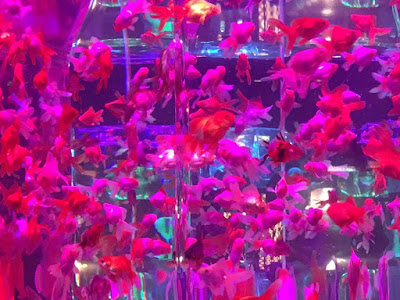This museum is located in the center of Tokyo called Nihonbashi. It is at the 7th floor of the Mitsui main building. Mitsui Echigo-ya, which was an original of Mitsui group, was there in the Edo period. It changed to Mitsukoshi department store in 1928.
 |
The model of Echigo-ya、越後屋の模型
|
東京日本橋、三井高利が始めた越後屋があった場所に立つ三井本館にある三井記念美術館。今は、三井不動産など関連企業が入るし、お隣は越後屋の後継、三越百貨店である。
There is no permanent exhibition, only
special exhibition is held. You need to check what exhibition is held before
you go. (http://www.mitsui-museum.jp/english/english.html)
I visited “Soboku-e – Japanese Innocent Painting through age” to
find the fun of good old Japanese. Photography is prohibited of course. Images
of exhibits on this article are pictures on the brochure or the poster.
企画展示のみで、常設展はないので、訪問前にご確認ください(http://www.mitsui-museum.jp/index.html)。私が見たのは、「日本の素朴絵-ゆるい、かわいい、楽しい美術-」、庶民の楽しみがあるかなあと思って行ってみた。写真撮影は、もちろん禁止で、頂いたパンフレットやポスターを使って紹介します。
The photo below is the entrance. There was a poster of lovely Soboku-e painting of monks.
美術館入り口。場所柄か、平日の15時頃なのに観覧者は、多かったです。一番気に入った、南天棒さんの人気作、雲水托鉢図、を使ったポスター。美術館の入り口に置いてありました。
It was written, “Today, the ubiquitous mascot figures, known in Japanese as Yuru-chara, have won widespread acceptance throughout the country. The word, ‘Yuru-chara’ is an abbreviation of a mixture of Japanese and English words: ‘yurui’ [naïve] and ‘character’. --- they attracted a lot of attention and soon became popular. However, if we look at art history, we realize that this love of ‘naïvity’ is not something that was appeared recently. In Japan, paintings in a variety of styles but all sharing the same element of ‘naïvity’ and possessing a relaxed atmosphere, have been produced and treasured throughout history. ---
In this exhibition, we refer to paintings that express this kind of ‘unsophisticated’, humorous taste as ‘soboku-e’ (Innocent Paintings). ---“
 |
| Singers and Fukushima's Yuru-chara "Yae-tan"、会津の八重たん |
 |
| Brochure、チラシ |
展示会入り口の案内に、
「日本では昔から、様々な形式の作品に緩やかなタッチでおおらかに描かれた絵が残っています。--- 本展覧会では、ゆるくとぼけた味わいのある表現で描かれたこのような絵画を「素朴絵(そぼくえ)」と表現します。---素朴絵は知識人や富裕層だけでなく、どの時代でも「庶民」が主体となって描き継がれ、残されてきた芸術といえます。---」
The exhibits were manga comics rather than art. The first one was the ancient clay figure of the hunter who held a wild boar with his right hand. His grimaced face relaxed me. The stone guardian dog, whose face is scared usually, smiled. It was something humorous.
In the room of picture scrolls and books, exhibits were almost manga. Those were simple picture and some stupid stories. Breaking wind competition, love affairs and fairy were depicted. In Tsukomo-gami god picture scroll, the god exterminated the demon by gas. What a foolish story! Those were drawn around 500 years ago.
It is said these are origin of manga, and they have attracted people regardless of rank.
 |
| Tsukishima picture scroll、つきしま絵巻 |
展示されている絵は、鑑賞をすると言うより、楽しむ漫画、と書いてしまうと失礼か。一番最初の展示品は、猪を抱える猟師の埴輪(古墳時代)。顔をゆがめているのでホッとさせてくれます。別の展示品の狛犬(17世紀)は、ニコッとしておどけています。
絵巻と絵本(奈良絵本)の展示室に行くと、ほぼ、漫画の世界。シンプルな絵が多いし、くだらない話を書いた物もある。
その中に、「勝絵」という勝ち負けのことを書く絵があるが、屁の合戦をやった(勝絵絵巻、15世紀)とか、男女の話を書いているつきしま絵巻(16世紀)、おようの尼絵巻(16世紀)、うらしま絵巻(16世紀)が展示されていた。「付喪神(つくもがみ)絵巻」では、神が屁で悪い妖怪を退治するというナンセンス話が書かれている。付喪神は、「長い年月を経た道具などに神や精霊(霊魂)などが宿ったもの」だ。
奈良絵や絵巻は漫画のルーツ言われていて、貴族から庶民まで多くの人たちを魅了したという。
Personified animals such as a mouse or a sparrow were depicted. Some animals played important roles. For example, a powerful monkey got married with a pretty girl, but a samurai boy regained her. In another story of Otu-e, which were souvenirs in the Edo period, a cat poured sake (alcohol) for a mouse so that the latter got drunk and the cat could eat him. It was a funny picture.
鳥獣戯画ではないが、擬人化した絵巻も沢山ある。雀のお宿の小藤太物語絵巻(16世紀)、鼠に擬人化した鼠草子絵巻(16世紀)など。猿に娘をやったが取り返しに行く藤袋草子絵巻(16世紀)のように動物と人間の関わりを書いた絵巻物もある。江戸時代の旅の土産として流行った大津絵の展示室もある。鼠に酒を飲ませて食べようとする猫を書いた「猫と鼠」(18世紀)が楽しい絵だった。
My favorite painting was in the last exhibition room, which was about Takuhatsu (pindapata) monks who seemed to be cute anime characters. They were coming and leaving. Nantenbou painted it around one hundred years ago. Nichousai also painted attractive scrolls in the Edo period. I think they were excellent cartoonists, however I also think current cartoonists entertain us more.
 |
| Takuhatsu monks by Nantenbou、雲水托鉢図 |
 |
| Samurai by Nichousai、耳鳥斎 |
最後の展示室7には、何とも可愛らしい絵が南天棒の雲水托鉢図(大正時代)があった。人気作だと言うが、托鉢坊主がほぼアニメキャラである。江戸時代の耳鳥斎(にちょうさい)の絵になるとほとんど漫画だ。でも、今の漫画家の方が、上かな。
The famous summer event “ART AQUARIUM” is held in the building which
is opposite side of the museum. We can see beautiful goldfishes in beautiful
bowls. People feel cool while watching goldfishes.
向かい側のコレドでは恒例のアートアクアリムが開催中。昔は金魚を見て涼をとったそうだ。
 |
| Lady with goldfish kimono、金魚柄の着物 |
Four funs(楽fun)were found. Visited in August, 2019
Official website : http://www.mitsui-museum.jp/english/english.html (English)
http://www.mitsui-museum.jp/index.html (Japanese), accessed in August, 2019
Previous post (Museum in Chiba, neighboring city of Tokyo):
Ichikawa history museum 市川歴史博物館
Next post (Museum in the neighboring prefecture, Ibaraki):
Tonegawa town history and folklore museum、利根川町歴史民俗資料館









Comments
Post a Comment